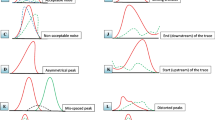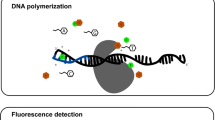Abstract
Improving the amplification and analysis of highly degraded DNA extracts has been a longstanding area of research in forensic genetics. One of the most promising recent developments in analysis of degraded DNA is the availability of short, biallelic insertion–deletion length polymorphisms (InDels) in highly multiplexed assays. InDels share many of the favourable characteristics of single-nucleotide polymorphisms (SNPs) that make them ideal markers for analysis of degraded DNA, including: analysis in short amplicon size ranges, high multiplexing capability and low mutation rates. In addition, as length-based polymorphisms, InDels can be analysed with the same simple dye-labelled PCR primer methods as standard forensic short tandem repeats. Separation and detection of fluorescently dye-labelled PCR products by capillary electrophoresis eliminate the multiple step protocols required by SNP typing with single-base extension assays and provide a closer relationship between the input DNA and the profile peak height ratios. Therefore InDel genotyping represents an effective new approach for human identification that adds informative new loci to the existing battery of forensic markers. To assess the utility of InDels for forensic analysis, we characterised population variation with two InDel identification assays: the 30-plex Qiagen DIPplex panel and a 38-plex panel developed by Pereira et al. in 2009 [1]. Allele frequencies were generated for the 68 markers in US African American, Caucasian, East Asian and Hispanic samples. We made a thorough assessment of the individual and combined performance of the InDel sets, as well as characterising profile artifacts and other issues related to the routine use of these newly developed forensic assays based on artificially degraded DNA and mixed source samples.



Similar content being viewed by others
References
Pereira R, Phillips C, Alves C, Amorim A, Carracedo Á, Gusmão L (2009) A new multiplex for human identification using insertion/deletion polymorphisms. Electrophoresis 30:3682–3690
Weber JL, David D, Heil J, Fan Y, Zhao C, Marth G (2002) Human diallelic insertion/deletion polymorphisms. Am J Hum Genet 71:854–862
Mills RE, Luttig CT, Larkins CE, Beauchamp A, Tsui C, Pittard WS, Devine SE (2006) An initial map of insertion and deletion (INDEL) variation in the human genome. Genome Res 16:1182–1190
Mullaney JM, Mills RE, Pittard WS, Devine SE (2010) Small insertions and deletions (INDELs) in human genomes. Hum Mol Genet 19(R2):131–136
Mills RE, Pittard WS, Mullaney JM, Farooq U, Creasy TH, Mahurkar AA, Kemeza DM, Strassler DS et al (2011) Natural genetic variation caused by small insertions and deletions in the human genome. Genome Res 21:830–839
Väli Ü, Brandström M, Johansson M, Ellegren H (2008) Insertion-deletion polymorphisms (InDels) as genetic markers in natural populations. BMC Genet 9:8
Romanini C, Catelli ML, Borosky A, Pereira R, Romero M, Salado Puerto M, Phillips C, Fondevila M et al (2011) Typing short amplicon binary polymorphisms: supplementary SNP and InDel genetic information in the analysis of highly degraded skeletal remains. Forensic Sci Int Genet. doi:10.1016/j.fsigen.2011.10.006
Zidkova A, Horinek A, Kebrdlova V, Korabecna M (2011) Application of the new insertion–deletion polymorphism kit for forensic identification and parentage testing on the Czech population. Int J Legal Med. doi:10.1007/s00414-011-0649-3
Larue BL, Ge J, King JL, Budowle B (2012) A validation study of the Qiagen Investigator DIPplex® kit; an INDEL-based assay for human identification. Int J Legal Med (in press)
Friis SL, Børsting C, Rockenbauer E, Poulsen L, Fredslund SF, Tomas C, Morling N (2011) Typing of 30 insertion/deletions in Danes using the first commercial InDel kit—Mentype® DIPplex. Forensic Sci Int Genet. doi:10.1016/j.fsigen.2011.08.002
Fondevila M, Pereira R, Gusmao L, Phillips C, Lareu MV, Carracedo A, Butler JM, Vallone PM (2011) Forensic performance of insertion–deletion marker systems. Forensic Sci Int Genet Suppl Ser 3:e443–e444
Golenberg E, Bickel A, Weihs P (1996) Effect of highly fragmented DNA on PCR. Nucleic Acids Research Nucleic Acids Res 24:5026–5033
Sikorsky JA, Primerano DA, Fenger TW, Denvir J (2007) DNA damage reduces Taq DNA polymerase fidelity and PCR amplification efficiency. Biochem Biophys Res Commun 355:431–437
Fondevila M, Phillips C, Naverán N, Fernandez L, Cerezo M, Salas A, Carracedo Á, Lareu MV (2008) Case report: identification of skeletal remains using short-amplicon marker analysis of severely degraded DNA extracted from a decomposed and charred femur. Forensic Sci Int Genet 2:212–218
Investigator DIPplex Kit. http://www.qiagen.com/products/investigatordipplexkit.aspx
Phillips C, Fondevila M, García-Magariños M, Rodriguez A, Salas A, Carracedo Á, Lareu MV (2008) Resolving relationship tests that show ambiguous STR results using autosomal SNPs as supplementary markers. Forensic Sci Int Genet 2:198–204
Phillips C, Ballard D, Gill P, Syndercombe Court D, Carracedo Á, Lareu MV (2012) The recombination landscape around forensic STRs: accurate measurement of genetic distances between syntenic STR pairs using HapMap high density SNP data. Forensic Sci Int Genet 6:354–365
Schneider S, Roessli D, Excoffier L (2000) Arlequin: a software for population genetics data analysis User manual ver 2.00. Genetics and Biometry Lab, Dept. of Anthropology, University of Geneva; Geneva
Kline MC, Butts ELR, Hill CR, Coble MD, Duewer DL, Butler JM (2011) The new Standard Reference Material 2391c: PCR-based DNA profiling standard. Forensic Sci Int Genet Suppl Ser 3:e355–e356
Eschelbach JW, Zhuome D, Grady B, Goetzinger W (2011) Characterization of short-term temperature, exposure, and solubilization effects on library compound quality. J Biomol Screen 16:1112–1118
Kline MC, Hill CR, Decker AE, Butler JM (2011) STR sequence analysis for characterizing normal, variant, and null alleles. Forensic Sci Int Genet 5:329–332
Coble MD, Butler JM (2005) Characterization of 26 miniSTR loci for improved analysis of degraded DNA samples. J Forensic Sci 50:43–53
Hill CR, Kline MC, Coble MD, Butler JM (2008) Characterization of 26 miniSTR loci for improved analysis of degraded DNA samples. J Forensic Sci 53:73–80
Kosambi DD (1943) The estimation of map distances from recombination value. Ann Eugen 12:172–175
Phillips C, Fondevila M, Vallone PM, Santos C, Freire-Aradas A, Butler JB, Lareu MV, Carracedo Á (2011) Characterization of U.S. population samples using a 34plex ancestry informative SNP multiplex. Forensic Sci Int Genet. Suppl Ser 3 (2011) e182–e183
Lao O, Vallone PM, Coble MD, Diegoli TM, van Oven M, van der Gaag KJ, Pijpe J, de Knijff P et al (2010) Evaluating self-declared ancestry of U.S. Americans with autosomal, Y-chromosomal and mitochondrial DNA. Hum Mutat 12:1875–1893
Ryckman K, Williams SM (2008) Calculation and use of the Hardy–Weinberg model in association studies. Curr Protoc Hum Genet 1:1.18
Sanchez JJ, Phillips C, Borsting C, Balogh K, Bogus M, Fondevila M, Harrison CD, Musgrave-Brown E et al (2006) A multiplex assay with 52 single nucleotide polymorphisms for human identification. Electrophoresis 27:1713–1724
Phillips C, Salas A, Sánchez JJ, Fondevila M, Gómez-Tato A, Álvarez-Dios J, Calaza M, Casares de Cal M, Ballard D, Lareu MV, Carracedo Á (2007) The SNPforID Consortium, Inferring ancestral origin using a single multiplex assay of ancestry-informative marker SNPs. Forensic Sci Int Genet 1:273–280
Pereira R, Phillips C, Pinto N, Santos C, dos Santos SEB, Amorim A, Carracedo Á, Gusmão L (2012) Straightforward inference of ancestry and admixture proportions through ancestry-informative insertion deletion multiplexing. PLoS One 7:e29684
Fondevila M, Santos C, Phillips C, Carracedo A, Butler JM, Lareu MV, Vallone PM (2011) An assesment of linkage between forensic markers: core STRs, mini-STRs and InDels. Proccedings of 22nd International Symposium of Human Identification, Washington. https://www.promega.com/∼/media/files/resources/conference%20proceedings/ishi%2022/oral%20presentations/fondevila.ashx?la=en. Accessed 1 February 2012
Acknowledgments
The authors wish to thank Margaret Kline and Becky Hill at NIST as well as Anke Prochnow at Qiagen. The work of MF at NIST has been supported by the Fundacion Barrie de la Maza postgrade grant program (2010). MVL was supported by funding from Xunta de Galicia INCITE 09 208163PR and Ministerio de Educación y Ciencia BIO2006-06178. The support by funding from the Fundacion Marcelino Botin to the Institute of Legal Medicine of the USC. CS was partially supported through a PhD grant (SFRH/BD/75627/2010) awarded by the Portuguese Foundation for Science and Technology (FCT) and co-financed by the European Social Fund (Human Potential Thematic Operational Program). The Institute of Molecular Pathology and Immunology of the University of Porto (IPATIMUP) is an Associate Laboratory of the Portuguese Ministry of Education and Science and is partially supported by FCT. RP holds an FCT fellowship (SFRH/BPD/81986/2011). LG is supported by a grant from CAPES/Brazil.
Disclaimer
This work was funded in part through an interagency agreement between the National Institute of Justice and the NIST Office of Law Enforcement Standards as well as funding from the FBI Biometric Center of Excellence: ‘Forensic DNA Typing as a Biometric Tool’. Points of view in this document are those of the authors and do not necessarily represent the official position or policies of the U.S. Department of Justice. Commercial equipment, instruments, and materials are identified in order to specify experimental procedures as completely as possible. In no case does such identification imply a recommendation or endorsement by the National Institute of Standards and Technology nor does it imply that any of the materials, instruments or equipment identified are necessarily the best available for the purpose.
Conflicts of interest
None.
Author information
Authors and Affiliations
Corresponding author
Electronic supplementary materials
Below is the link to the electronic supplementary material.
Supplementary Fig. S1
Covaris AFA-treated DNA analysis. Four samples were 3.4 ng/μL and treated with: 1 100 cycles/burst, 5 min, 1-mL container; 2 1,000 cycles, 20 min, 1 mL; 3 1,000 cycles, 6 min, 100-μL container; 4 1,000 cycles, 20 min, 100 μL. The last conditions (sample 4) were chosen for artificial fragmentation PCR analysis. (JPEG 34 kb)
Supplementary Fig. S2
Individual PHR distribution charts for each artificial mixture arranged in similar format to the graphs if Fig. 2, with the addition of control heterozygote means, lower/upper quartile boxes and extreme values shown as whiskers. This allowed counts of mixture sample PHRs outside both these normal ranges, strongly indicating the presence of a mixture. (PDF 157 kb)
Supplementary Table S2
Sequencing primers used to characterise four DIPplex InDels showing mobility shift (D84, D99) or imbalanced signal alleles (D83, D97). (DOCX 11 kb)
Rights and permissions
About this article
Cite this article
Fondevila, M., Phillips, C., Santos, C. et al. Forensic performance of two insertion–deletion marker assays. Int J Legal Med 126, 725–737 (2012). https://doi.org/10.1007/s00414-012-0721-7
Received:
Accepted:
Published:
Issue Date:
DOI: https://doi.org/10.1007/s00414-012-0721-7




